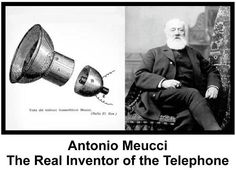The turbulent times that Italy lived in the 30s of the nineteenth century will make Antonio Meucci leave, along with his wife, his native Florence, away from the hundreds of revolutionaries and reunification that was being forged. The couple arrived in the city of Havana, Cuba, where the inventor got a job in the Gran Teatro de Tacón (which today is the Gran Teatro de La Habana).
Meucci lived in Havana since 1835 and as we said he worked as a “mechanic” at the Tacón Theater. His job was to install and direct the operation of the stage, prepare and care for the sets, props and props. For that an accumulation of knowledge was needed that included painting, physics, chemistry, history and plastic arts.
The passion for the study surpassed in Meucci the necessary one for the performance of its profession and it got to be a true wise person for his time in matter of electricity. His restless spirit and the knowledge derived from his studies in Chemistry and Mechanics led him to do various experiments. In one of them he discovered that electricity could transmit the human voice: the basic principle of the telephone. He was applying electrotherapy to a patient and he received a current that made him scream. Perhaps it was something of his imagination, but Meucci, in another room, thought he had heard more clearly the sound of what was possible while at a distance. Then he checked that one of the wires was carrying his patient’s voice in a faint way. He discovered, between 1849 and 1850, how to obtain the transmission of voices through a conductor wire attached to several batteries to produce electricity. He had called his invention “talking telegraph” and also “tele-phone”.
Several researchers have come to the conclusion that, although it was not Cuban, it was in Havana that the true inventor of this media outlet carried out his most conclusive experiments. The Italian Antonio Meucci, although he is not considered the definitive inventor of the telephone, did carry out in the Island the experiments that determined his contribution in the search of the medium capable of transmitting the voice from a distance.
In 2002, the Congress of the United States approved a resolution in which the name of Antonio Meucci associated with the invention of the telephone stood out, to the detriment of Bell. For more than 100 years, the latter was credited with having created one of the devices that marked the 20th century.
But let’s refer to the use of the telephone as a practical reality.
The first local telephone service that began to operate steadily and which is known, was opened in New Haven and then in New York, between 1877-78.
Three years later, although incipiently and provisionally, several North American and European cities could already boast of having the service. A Havana would arrive in September 1881 as a kind of supplementation that was offered from the official telegraphic center.
In 1883, the first telephone center of a North American company was installed in the old number 5 O’Reilly Street. And soon began to place phones between merchants and professionals.
The first particular device that was placed in Cuba was that of the Casa Ginerés y Compañía, merchants established a few meters from the telephone exchange itself. His phone was number 2, since the number 1 was reserved to the telephone center itself. The number 3 was acquired by Julián Álvarez, owner of the Henry Clay cigar factory; the pharmacy of San José, number 4; l The importers of Aedo, Veiga y Compañía, 5; the Funeral Train of Ramón Guillot, 6; and the Captaincy General, with its slow and tortuous bureaucratic process, came to acquire the number 50.
By 1910, Cuba already had one of the first automatic systems that existed in the world. The Cuban telephone services were served by the so-called “switchboards”, attended mostly by beautiful young ladies.
So much was his success that many called only to speak with the “Central!” “That reached a record number of lovers in Havana. There were many of these “beautiful ladies” who broke the hearts of more than one Cuban, and others who, upon listening to the call, reported more than any newspaper of the daily talk of the Cuban society of the time. That is why some grandparents remember those times with pleasure and even come to exclaim: “Candela that were those switchboards!
CUBA FUÉ QUIZÁS LA PRIMERA NACIÓN DONDE REPIQUETEÓ EL TELEFONO. SU HISTORIA.
Los tiempos turbulentos que vivió Italia en los años 30 del siglo XIX harán que Antonio Meucci se vaya, junto con su esposa, su Florencia natal, lejos de los cientos de revolucionarios y la reunificación que se estaba forjando. La pareja llegó a la ciudad de La Habana, Cuba, donde el inventor consiguió un trabajo en el Gran Teatro de Tacón (que hoy es el Gran Teatro de La Habana).
Meucci vivió en La Habana desde 1835 y, como dijimos, trabajó como “mecánico” en el Teatro Tacón. Su trabajo consistía en instalar y dirigir la operación del escenario, preparar y cuidar los sets, los accesorios y los accesorios. Para eso, se necesitaba una acumulación de conocimiento que incluye pintura, física, química, historia y artes plásticas.
La pasión por el estudio superó en Meucci la necesaria para el desempeño de su profesión y llegó a ser una verdadera persona sabia para su época en materia de electricidad. Su espíritu inquieto y el conocimiento derivado de sus estudios en Química y Mecánica lo llevaron a hacer varios experimentos. En uno de ellos descubrió que la electricidad podía transmitir la voz humana: el principio básico del teléfono. Estaba aplicando electroterapia a un paciente y recibió una corriente que lo hizo gritar. Tal vez era algo de su imaginación, pero Meucci, en otra habitación, pensó que había escuchado más claramente el sonido de lo que era posible mientras estaba lejos. Luego, comprobó que uno de los cables llevaba la voz de su paciente de una manera tenue. Descubrió, entre 1849 y 1850, cómo obtener la transmisión de voces a través de un cable conductor conectado a varias baterías para producir electricidad. Él había llamado a su invención “telégrafo parlante” y también “teléfono”.
Varios investigadores han llegado a la conclusión de que, aunque no era cubano, fue en La Habana donde el verdadero inventor de este medio de comunicación llevó a cabo sus experimentos más concluyentes. El italiano Antonio Meucci, aunque no es considerado el inventor definitivo del teléfono, sí realizó en la Isla los experimentos que determinaron su aporte en la búsqueda del medio capaz de transmitir la voz a distancia.
En 2002, el Congreso de los Estados Unidos aprobó una resolución en la que destacó el nombre de Antonio Meucci asociado a la invención del teléfono, en detrimento de Bell. Durante más de 100 años, a este último se le atribuyó haber creado uno de los dispositivos que marcó el siglo XX.
Pero vamos a referirnos al uso del teléfono como una realidad práctica.
El primer servicio telefónico local que comenzó a funcionar de forma estable y del cual se tienen noticias ,fue inaugurado en New Haven y luego en New York, entre 1877-78.
Tres años más tarde, aunque de manera incipiente y provisional, varias ciudades norteamericanas y europeas ya podían presumir de contar con el servicio. A La Habana llegaría en septiembre de 1881 como una especie de suplementación que se ofrecía desde el centro oficial telegráfico.
Ya en 1883 se instala el primer centro telefónico de una empresa norteamericana en el antiguo número 5 de la calle O´Reilly. Y enseguida se empezaron a emplazar teléfonos entre comerciantes y profesionales.
El primer aparato particular que se colocó en Cuba fue el de la casa Ginerés y Compañía, comerciantes establecidos a pocos metros de la propia central telefónica. Su teléfono era el número 2, ya que el número 1 se le reservó al propio centro telefónico. El número 3 lo adquirió Julián Álvarez, dueño de la tabaquería Henry Clay; la botica de San José, el número 4; lLos importadores de Aedo, Veiga y Compañía, el 5; el Tren Funerario de Ramón Guillot, el 6; y la Capitanía General, con su lento y tortuoso proceso burocrático llegó a adquirir el número 50.
Ya para el año 1910 Cuba contaba con uno de los primeros sistemas automáticos que existió en el mundo. Los servicios telefónicos cubanos estuvieron servidos por las llamadas “centralitas”, atendidas mayormente por señoritas hermosas.
Tanto fue su éxito que muchos llamaban tan solo para hablar con la “!Central!»” que llegó a alcanzar una cifra record de enamorados habaneros. Hubo muchas de estas “hermosas damas” que le destrozaron el corazón a más de un cubano, y otras que, al quedar a la escucha al pasar la llamada informaban más que cualquier periódico de la comidilla diaria de la sociedad cubana de época. Por eso algunos abuelos recuerdan aquellos tiempos con agrado y hasta llegan a exclamar:” ¡Candela que eran aquellas centralitas!
Agencies/CubaPerdida/Livan Escandell/Bejerano/Internet Photos/ Arnoldo Varona/ TheCubanHistory.com
THE CUBAN HISTORY, HOLLYWOOD.



 > CUBA was Maybe the First Nation where the Telephone Sounded. Its History. <> CUBA fué Quizás la primera Nación donde repiqueteó el telefono. Su Historia.
> CUBA was Maybe the First Nation where the Telephone Sounded. Its History. <> CUBA fué Quizás la primera Nación donde repiqueteó el telefono. Su Historia.







